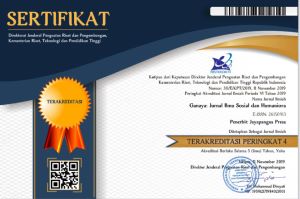Eksistensi Ratam Bagi Penanaman Visi Dan Misi Prodi Teologi Hindu Di STAHN Mpu Kuturan Singaraja
DOI:
https://doi.org/10.37329/ganaya.v4i2.1396Keywords:
Ratam, Vision, MissionAbstract
Ratam activities in the Hindu Theology Study Program are held in the framework of campus life orientation for new students (maba). In the implementation of ratam activities there are efforts to build communication and familiarity between all academic communities in the Hindu Theology Study Program. The vision of the Hindu Theology Study Program is: "Superior and Dignified Study Program of Tri Kaya Parisudha character". While the mission of the Hindu Theology Study Program is 1) Organizing quality Hindu Theology education to produce graduates of character, superiority and dignity; 2) Conduct innovative research in the development and application of Hindu Theology. 3) Organize community service in the field of Hindu Theology. Understanding of the vision and mission of the Hindu Theology Study Program by all academic community contained in it, is the fundamental point that determines the success of the work program that has been established. The background of the ratam is to socialize the vision of the Hindu Theology Study Program mission and strengthen the sense of brotherhood for the academic community in the Hindu Theology Study Program. Through the socialization of vision and mission, it is hoped that it can strengthen the understanding of the values contained in the concept of Tri Kaya Parisudha and increase solidarity between academic community in Hindu Theology Study Program.
References
Atmaja, N.I.M, dkk. (2010). Etika Hindu. Surabaya: Paramita.
Atmadja, Nengah Bawa. (2014). Saraswati dan Ganesha Sebagai Simbol Pradigma Interpretativisme dan Positivisme. Denpasar : Universitas Hindu Indonesia.
Badudu, Rizal. 2019. Character Excellence Mengembangkan Karakter Anak, Siswa dan Karyawan. Jakarta : PT Gramedia.
Bagus, L. (2002). Kamus Filsafat. Jakarta: Gramedia Pustaka Utama.
Cardani, L. (2000). Corporate Mission Statements: A Strategic Management Issue.
Depdiknas. (2007). Kamus Besar Bahasa Indonesia. Jakarta: Gramedia Pustaka Utama.
Hamdan, Yusuf. (2001). PERNYATAAN VISI DAN MISI PERGURUAN TINGGI. Mimbar: Jurnal Sosial dan PembangunanVolume XVII No.1. 90-103.
Jones, P., Larry, K. (1999). Misi dan Visi 50 Perusahaan Terkenal di Dunia. Jakarta: Interaksara.
Setia, I.P. (1993). Suara Kaum Muda Hindu. Jakarta: Yayasan Dharma Nusantara.
Suhardi. (2013). The Science of Motivation (Kitab Motivasi). Jakarta: PT Gramedia.
Ratna, Nyoman Kutha. (2014). Peranan Karya Sasatra, Seni, dan Budaya dalam Pendidikan Karakter. Yogyakarta : Pustaka pelajar.
Ratminingsih, Ni Made. (2019). Pengajaran, Karakter dan Cinta. Singaraja : Mahima.
Tim Penyusun. (2014). Pemahaman dan Implemetasi Visi Misi dalam Kegiatan Akademik di Prodi Sosioloi Agama Fakultas Ushuluddin dan Filsafat. Penelitian Berbasis Universitas Islam Negeri Alauddin Makasar.
Titib, I.M. (1996). Veda Sabda Suci Pedoman Praktis Kehidupan. Surabaya: Paramita.
Watra, I Wayan. (2006). Filsafat Manusia Dalam Perspektif Hindu. Surabaya : Paramita.
Yudianti, Anna Lisana. (2018). Implementasi Visi dan Misi Sekolah dalam Membina karakter Religius Siswa (Studi Komparasi di SMP N 8 Yogyakarta dan SMP N 1 Yogyakarta). Tesis UIN Sunan Kalijaga.
Downloads
Published
How to Cite
Issue
Section
License
An author who publishes in the Ganaya : Jurnal Ilmu Sosial dan Humaniora agrees to the following terms:
- Author retains the copyright and grants the journal the right of first publication of the work simultaneously licensed under the Creative Commons Attribution-ShareAlike 4.0 License that allows others to share the work with an acknowledgement of the work's authorship and initial publication in this journal
- Author is able to enter into separate, additional contractual arrangements for the non-exclusive distribution of the journal's published version of the work (e.g., post it to an institutional repository or publish it in a book) with the acknowledgement of its initial publication in this journal.
- Author is permitted and encouraged to post his/her work online (e.g., in institutional repositories or on their website) prior to and during the submission process, as it can lead to productive exchanges, as well as earlier and greater citation of the published work (See The Effect of Open Access).
Read more about the Creative Commons Attribution-ShareAlike 4.0 Licence here: https://creativecommons.org/licenses/by-sa/4.0/.








